Fifth Stalinist strike. Part of 7. Destruction of the Minsk group of the enemy
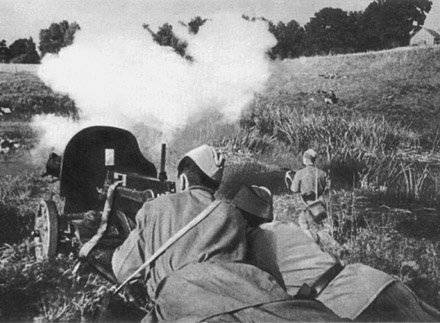 The offensive of the 2 of the Byelorussian Front and the encirclement of the German forces east of Minsk
The offensive of the 2 of the Byelorussian Front and the encirclement of the German forces east of MinskThe troops of the 2 of the Byelorussian Front under the command of G. F. Zakharov during the Minsk operation continued to accomplish the task that the Headquarters set the front for 31 of May 1944 of 2 of the Byelorussian Front was to cross the Dnieper and develop an offensive in the direction of Mogilyov - Berezino - Smilovichi. 28 June this task has been updated. The Supreme High Command set the task for the troops of the 2 of the Belarusian Front no later than 30 of June - 1 of July to cross the Berezina River and quickly develop an offensive in the Minsk direction, without engaging in battle with the surrounding garrisons of the enemy, which will remain in the strongholds. The directive from 28 June also set the task no later than 7-8 of July with the connections of the 1 of the Belarusian Front and the 3 of the Belarusian Front to liberate Minsk from the Nazis and reach the western bank of the Svisloch River.
On June 29, Soviet troops crossed the Drut river for a large distance and continued their advance to the west. The German command organized a series of counterattacks on our right flank and in the center, but they were reflected. The troops of the 33, 49 and 50 armies continued their offensive, surrounding and destroying scattered enemy groups.
On June 30, the defeated formations of the German 27th, 12th Army and 39th Panzer Corps of the 4th Army continued to retreat to the west. At the same time, strong enemy rearguards continued to launch strong counterattacks with forces from battalion to infantry regiment, supported by tank and assault units. On the right wing of the Soviet front, the partially encircled remnants of the divisions of the 27th Army Corps (including the 25th Panzer Grenadier Division) made counterattacks to break through in a westerly direction.
The troops of the 33 Army under the command of Kryuchenkin fought to destroy the enemy grouping half-circled in the region east and southeast of Kruch. The enemy grouping consisted of broken parts of the 260, 110 of the infantry, 25 of the tank-grenadier and 287 of the guard divisions, as well as separate security and special units. The German grouping had 40-50 tanks and actively tried to break through to the west. The left and right flanks of Kryuchenkin’s army continued their offensive in the western direction and partly crossed the Drut River.
Parts of the 49th army led by Grishin, breaking the resistance of the enemy rearguards, which was especially strong in the Minsk highway area, advanced 35-40 km. The 50th Army of Boldin, overcoming the resistance of German troops, was moving in an impenetrable wooded area. By the end of June 30, the army in various directions advanced from 10 to 40 km and left on the left flank to Berezina. In general, the advance of the front developed successfully, the German rearguards circumvented or destroyed, without slowing down the pace of the offensive. Aviation the front delivered powerful bombing and assault strikes on clusters of enemy manpower and equipment in the area east of Berezino.
On July 1, front-line troops continued their offensive to the west, knocking down and destroying German barriers and individual units remaining in the Soviet rear. In the offensive zone of the 33 Army continued stubborn battles with the retreating enemy forces. In the center, fierce battles were fought in the Pogost area, the troops of the 49 Army reached the Berezina River and began to force it. On the left flank, the two corps of the 50 Army forced the Berezina and developed an offensive in the north-west direction. 4-I air army continued to bomb and deliver assault attacks on the enemy in the area west of the city of Berezino. The day was made around 600 sorties.
July 2 The 2 Belorussian Front continued its successful offensive. On the right wing and in the center of the front, numerous enemy counterattacks had to be repulsed. In the rear destroyed a group of German troops who did not have time to move. Thus, on the right wing, the troops of the 33 Army destroyed an enemy battalion group reinforced in the Orekhovka area, reinforced with tanks and assault guns. The captured was captured before 300 soldiers and officers of the enemy. Soviet trophies were 8 tanks, 12 multi-barrel mortars and more. weapon, equipment and property.
49-I army forces 69-th rifle corps forced Berezina and started a battle for the city of Berezino. The 81 th rifle corps, advancing along the Minsk highway, took possession of Pogost, Leshnitsa and by the end of the day went to Berezina, starting preparations for the crossing of the river. The 70 th rifle corps also reached Berezina and partly crossed the river.
The troops of the 50 Army in a day advanced by 18-40 km. The right flank of the army reached Berezina. The troops of the center and the left wing reached the Minskoe highway and occupied Cherven. The forward detachment was in 45 km from Minsk. In the evening of July 2, the Military Council of the 2 of the Belorussian Front decided to strengthen the 50 Army. It was handed over to the 70 th rifle corps, the 64 th and 199 th rifle divisions with reinforcement means from the 49 th army. The 50 Army received the mission to form the main army attack force on the right flank and advance along the Minsk road. 5 July 50-I army was to go to Minsk. The city was planned to be liberated along with the troops of the 1 of the Byelorussian Front.
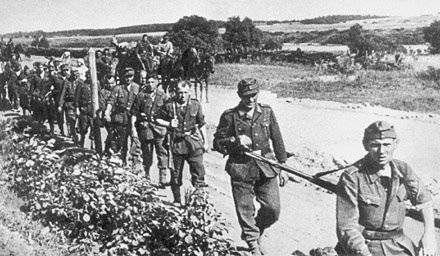 Environment Minsk group
Environment Minsk groupJuly 3 Soviet troops continued a successful offensive. Combinations of the 33 Army completed the defeat of the German group, which consisted of the remnants of two infantry, tank-grenadier divisions and several separate units in the area of forests northeast of Zhukovets. Separate enemy groups, abandoning heavy weapons and vehicles, fled in a westerly direction. Army divisions forced Berezina. As a result of the liquidation of the enemy grouping, about 3 thousand German soldiers and officers were killed, about 100 thousand people were taken prisoner. 17 tanks (including 4 heavy Tiger tanks), 20 assault guns, 120 field guns, 52 multilateral mortars, more than 1,5 thousand vehicles, and many other weapons, equipment and equipment were captured as trophies.
49-I army across the front forced the Berezina, liberated the city of Berezino and continued the offensive, smashing the enemy barriers. The enemy grouping, which consisted of units of two divisions (including the 78 th assault division), was defeated. German troops continued to roll back to the west, resisting with the help of cover groups formed from machine gunners, reinforced with tanks and self-propelled guns. By the end of the day, units of the 49 Army advanced by 20-35 km.
The units of the 50 Army for the day passed to 45 km. The forward detachments of the 38 Infantry Corps made their way to the eastern and south-eastern outskirts of Minsk. The 19 th rifle corps intercepted the withdrawal paths of the German 4 th army from the Smilovichi area in the western and south-western directions. The 121 Rifle Corps crossed the Berezina River and entered the Cherven area.
As a result, the troops of the 2 of the Byelorussian Front crossed the Berezina River along its entire length, passing from 25 to 45 km in a day. The forward detachments reached the eastern outskirts of Minsk. On the same day, the Belarusian capital was liberated from the German occupiers. The right wing and the center of the front broke two German groups. German troops continued to retreat quickly to the west, trying to jump out of the encirclement ring, resisting strong rearguards.
On July 4, the troops of the 33 Army of Kryuchenkin, knocking down enemy screens, blocked the northern withdrawal path to the German troops. Part of Grishin's 49 Army, overcoming the resistance of individual enemy units and difficult terrain (forests and swamps), developed an offensive to the west. The advance detachment entered the region north of Smilovichi. On this day, the 50 Army of Boldin continued to move westward with a part of the forces, with some forces advancing to the north and northwest, cutting off the enemy from the withdrawal routes to the south and southwest. On this day, from the 1 of the Belarusian Front, the 2 Army was transferred to the 3 of the Belarusian Front.
Results of the five-day offensive of the troops of the 2 of the Byelorussian Front
The troops of the front forced the rivers Drut and Berezina, passed through inaccessible terrain to 150 km. During this time, more than 13 thousand German soldiers and officers were destroyed and captured, a large number of weapons, equipment and various military equipment were eliminated and seized.
The troops of the 2 of the Belorussian Front surrounded the main forces of the German 4 Army and began their destruction. At the same time, part of the forces of the front continued to develop the offensive to the west.
A major role in the development of the success of the Zakharov offensive was played by partisan formations. The guerrillas destroyed enemy communications, lines of communication, arranged ambushes and sabotage, which significantly slowed down the transfer of forces and reserves of the enemy. The German command was forced to allocate significant forces to protect the rear and means of communication. The partisans also rendered the front troops a great help in finding convenient ways of movement, in reconnoitering the enemy forces. During the withdrawal of German troops, the partisans saved many villages from destruction and burning.
The offensive 3 of the Byelorussian Front. Liberation of Minsk and Slutsk
While units of the 48 and 65 armies were completing the destruction of the Bobruisk enemy grouping, the rest of the front armies continued the offensive against Minsk and Slutsk. The 3 Army under the command of Gorbatov advanced along the Svisloch-Pukhovichi line. The 65 Army under the command of Batov, with part of their forces, attacked the line Osipovichi - Slutsk. 28-I army Lucinschi moved in the general direction to Glusk, Lyuban and Pogost. At the junction of the 65-th and 28-th armies plievan mechanized group (KMG) was advancing.
Rokossovsky sought to develop the success of the Bobruisk operation, with a powerful blow to the 3 Army and the 1 Guards Tank Corps to the north-west to cover the Wehrmacht Minsk grouping from the south, and in the shortest possible time in cooperation with the forces of the 1 and 2 about the Belarusian fronts her surroundings. The troops of the 65 and 28 armies were to liberate Slutsk, preventing the German troops from consolidating at the Minsk-Slutsk line and advancing in the direction of Baranavichy.
The advance of the Soviet troops was very fast. German troops were defeated, and almost without resistance, in small groups retreated towards Minsk and Slutsk. 28 June Svisloch, Osipovichi were released. KMG, moving along the roads Bobruisk - Slutsk and Glusk - Pogost, occupied the Old Roads and advanced to Slutsk. The Soviet Air Force (16-I Air Army) provided the ground forces with a lot of support, making more than 27 thousand sorties during 28-2 in June. Aircraft attacked retreating columns, enemy defense units.
In an effort to free the Belarusian capital as quickly as possible, Rokossovsky ordered the commander of the 65 army to accelerate the movement of the 1 Don Guards Tank Corps in the north-west direction and seize the area Pukhovichi. The commander of the 3 Army received an order to strengthen the 9 tank corps with motorized infantry, anti-tank artillery, mortars and quickly advance in the direction of Puhovichi - Minsk.
1-th Guards Tank Corps, moving along the highway to Pukhovichi, initially did not meet the resistance of the enemy and by the end of 29 June came to the Svisloch River. However, during the crossing of the river, the Germans launched a strong counter-attack against the Soviet troops. The German command, trying to stop the coverage of Minsk from the south, deployed the 12 tank division to this region. The Soviet command immediately sent significant aviation forces to the area. Soviet aircraft subjected the enemy to a powerful air strike, but the Germans could not immediately break the resistance. The Germans fiercely counterattacked and forced the Soviet tankmen to retreat, to force the river on the move failed. Only 2 July, the enemy defense was broken. The guards on the shoulders of the enemy broke into Pukhovichi and freed them.
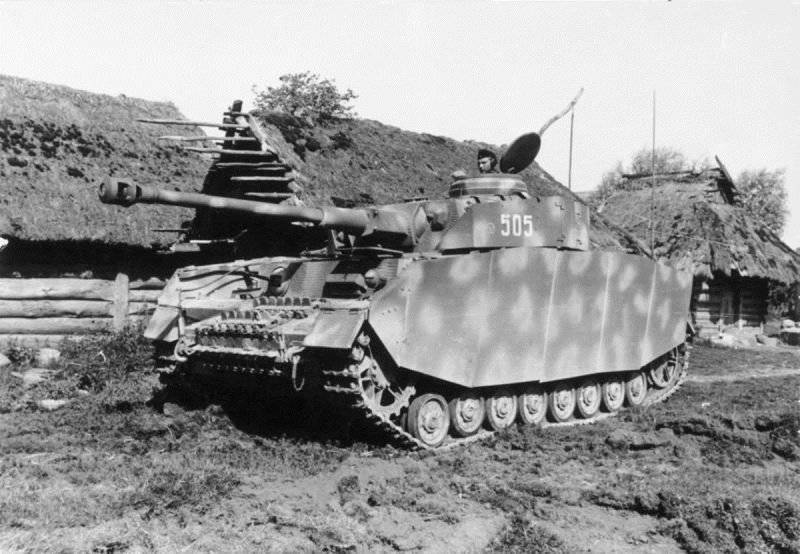
Tank Pz.Kpfw.IV 12-th Panzer Division of the Wehrmacht on the Eastern Front.
The troops of the 3 Army waged heavy battles with German troops northeast of Puhovichi, slowly moving towards the Svisloch River. Part of the forces of the army combined with the troops of the 2 of the Byelorussian Front.
On July 3 in the 13 watch, parts of the 1 of the Don Guards Tank Corps reached the south-eastern outskirts of Minsk. Aircraft 16-th Air Army, accompanying the movement of the tank corps, dealt a strong blow to the southern outskirts of the city, where the enemy, according to intelligence, was preparing to put up serious resistance. By the 16 clock, the 3 Army formations reached the city. As a result, the troops of the 3 of the Byelorussian Front, together with the forces of the 1 and of the 2 of the Byelorussian Front, took part in the liberation of Minsk and completed the encirclement of the Wehrmacht Minsk group. July 4 The headquarters transferred the 3 Army to the 2 Belorussian Front.
At this time, the main forces of the 3 of the Byelorussian Front continued the offensive in the Slutsk direction. 29 June, the main forces of KMG came to Slutsk. The city was prepared for all-round defense. Slutsk defended up to two regiments of infantry reinforced with tanks. The Germans met the advanced units of KMG with artillery fire. German aviation stepped up its activities. German planes fired at the roads, struck at Osipovich, the Old Roads and Gluska. Pliev ordered 30 Jun in the morning to attack the city from three directions. Cavalry divisions struck from the south and north, from the east their advance was supported by the mechanized corps.
On the morning of June 30, after a small artillery strike, the Soviet troops launched an offensive. 4-th Guards Cavalry Corps with strong blows broke through the enemy defenses on the flanks and rushed to the center of the city. At the same time, the soldiers of the 219 tank brigade also broke down the German defenses in the east. The Germans panicked and, throwing down their weapons, ran. However, in the city itself, German troops put up stubborn resistance. Many houses were equipped with firing points.
At 8 in the morning hours, German troops launched a strong counter-attack on the southwestern outskirts of the city. The attack went to the infantry regiment with the support of tanks and artillery. The Germans were able to press parts of the 9 Cavalry Division to the city center. The Soviet command transferred an artillery regiment to the aid of cavalrymen. The artillerymen destroyed several enemy tanks with strong direct fire, and the German infantry suffered heavy losses from Soviet artillery fire. The enemy's resistance finally broke the attack of the 35 th motorized rifle brigade of the 1 th mechanized corps. In addition, from the south, the 3-th Guards Rifle Corps of the 28-Army marched around the city. Attacked from several directions, the Germans flinch and ran west. By 11 clock Slutsk was released from the Nazis.
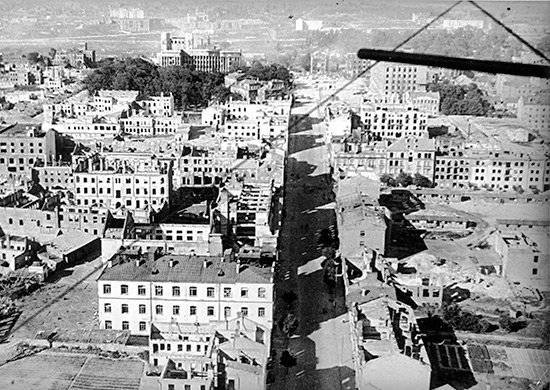
Minsk on the day of liberation
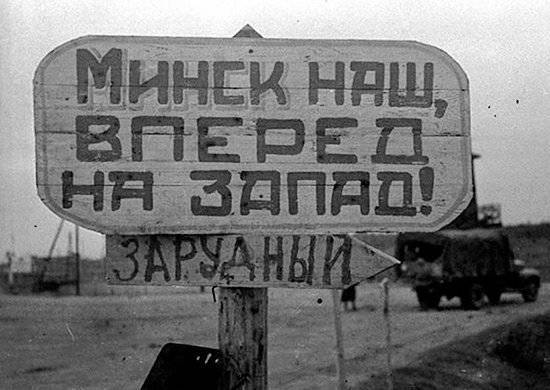
Further offensive forces Rokossovskogo
The remnants of the Slutsk garrison hurriedly retreated to the city of Baranavichy, which was turned into a strong stronghold. Rokossovsky decided to continue the offensive and take Baranavichy. The 48 army entered the battle, which was liberated after the liquidation of the Bobruisk enemy group. Despite the difficult terrain for the movement, Romanenko’s army advanced rapidly. 4 July 48-I army captured settlements Pogoreloye, Uzda and advanced units to the river Neman near the town of Stolbtsy.
65-I army, smashing individual enemy units, by the end of 4 July advanced units came to the City and Nesvizh. The 28 Army of July 4 crossed the Lan River and advanced on Lyakhovichi.
KMG, after the release of Slutsk, successfully developed the offensive. 2 July 4-th Guards Corps corps liberated Columns, City, Nesvizh, passing more than 80 km. 1 th mechanized corps, was forced to overcome the resistance of the enemy and move through the marshland, so moving slowly. The aviation of the 3 of the Byelorussian Front struck hard at Baranavichy.
3 July the resistance of the German troops increased sharply. Cavalry divisions met fierce opposition. The German command organized a series of counterattacks by forces up to a battalion of infantry supported by tanks and assault guns. Kavkorpus was forced to go on the defensive. The enemy strengthened the Baranovsk grouping of the 4 Panzer Division. The remains of seven infantry divisions (from the 35-th, 41-th and 55-th army corps of the 9-th army) were hastily put in order, replenished and organized defense around Baranavichy.
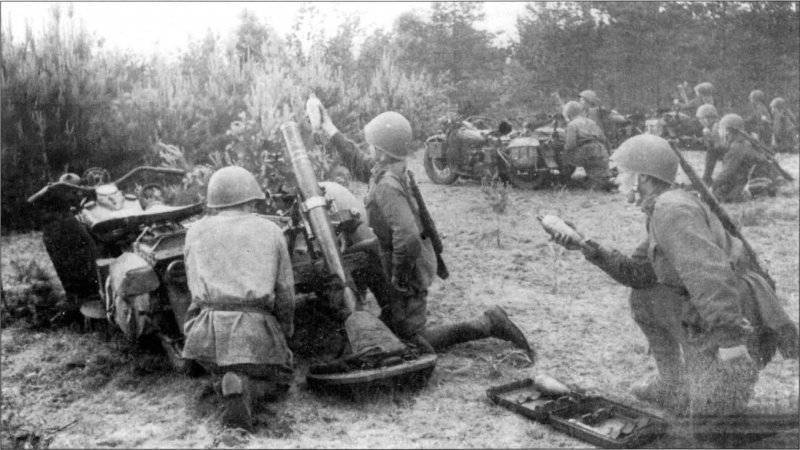
Soviet mortar platoon firing at an enemy in the area of Baranavichy
The results of the offensive 3 of the Byelorussian Front
By the end of July 4, Rokossovsky's troops had accomplished the tasks assigned to them by the Supreme Command General Headquarters. The right flank of the front, together with the troops of the 2 of the Byelorussian and 1 of the Byelorussian Front, surrounded the Minsk group of the Wehrmacht. The city of Minsk was liberated.
On the Slutsk direction, the German troops suffered a defeat. The city of Slutsk was liberated. The center and the left wing of the front reached the city of Baranavichy, which the Germans had turned into a major stronghold. Conditions were created for further offensive.
Liquidation of encircled German troops near Minsk
While the main forces of the four Soviet fronts continued to advance to the west, in the region to the east and south of Minsk, the liquidation of the surrounded German group was going on. 33-I army received the task to concentrate in the area of Minsk. With its right flank, it advanced south of the Moscow-Minsk road, blocking the enemy’s path to the north-west. The center and the left flank of the army squeezed the German grouping in the Volma area. The 49-I and 50-I armies of the main forces moved south of Minsk, partly blocking the enemy grouping from the south and south-west.
By July 5, remnants of the German army piled up in forests east of Minsk. German troops were divided into two groups. The first was located in the region northeast of Volma. These were units of the 12 Army Corps of the 4 Army. The second group was located in the area south-east of Volma. The core of this group was the divisions of the 27 Army Corps 4. In addition, surrounded by the fallen separate parts of the 39-th tank (4-th army), 41-th and 35-th army corps (9-I army). In total, the environment included broken 18 infantry, 3 motorized, 2 anti-aircraft, armored, assault and security divisions, as well as a large number of different separate and special units and subunits. The German group had more than 100 thousand people.
Before 4 July, German troops had no connection with the command - the headquarters of the 4 Army managed to slip to the west and did not get into the "boiler". The troops mixed up and, having lost control, vainly rushed along forest roads and paths, hoping to find a way out. On July 5, communication with the command was restored, and the surrounded army was ordered to make its way to its own. At night, surrounded by troops dropped ammunition and food.
German troops tried to tear in two directions. Lieutenant-General Traut's group (commander of the 78 th assault division from the 27 corps) attempted to break through in a southwesterly direction, through the Smilovichi area. The second group, under the command of Lieutenant General Muller (commander of the 12 Army Corps), was to break through bypassing Minsk, from the south to Dzerzhinsk. Both groups sought out Baranavichy.
6 July the Germans went for a breakthrough. Trout's group tried to make its way through the highway Mogilev - Minsk in the area of Smilovichi. However, units of the 49 Army in the course of the 4 hour fierce battle destroyed the vanguard of the enemy. On the same day, Trout's group attempted to break through to the crossing over the Svisloch River, but was crushed. Trout himself, the commander of the artillery of the 12 Corps, the chief of intelligence of the corps headquarters were captured. The Germans lost about 3,5 thousand people.
The Muller group on the same day tried to break through bypassing Minsk. However, the Soviet command promptly redeployed part of the 113 th rifle corps of the 31 th army to the south and south-east of Minsk. German troops suffered heavy losses and were thrown back. Two advanced German detachments in 800 and 1 thousand people were able to go further, but were blocked and destroyed by the troops of the 50 army. The 38 th rifle corps of the 50 th Army occupied the front eastward, blocking the withdrawal paths to the south-west. 49-I army allocated three more infantry divisions to eliminate the German group.
July 7 the most brutal battles were for crossings on the river Svisloch. The Germans stubbornly rushed to the south-west. German troops have achieved some local success. However, the approaching Soviet divisions defeated the enemy’s forces at the crossings, then in the Kaikovo area 5-thousand were surrounded and destroyed. group, which managed to cross the river. On the same day, Soviet troops defeated several more German groups.
July 8 fights continued. Soviet troops destroyed several significant enemy units. The 369 Rifle Division surrounded and completely destroyed a large group of the enemy in the area south of Dukorschina. The commander of the Feldkhernhalle Tank-Grenadier Division (the former 60 motorized division), Major General Friedrich von Steinkeller, was taken prisoner with his headquarters. In this battle, 1,5 was destroyed by thousands of Germans.
Another large group was crushed in the area of Samokhvalichi. First, the Germans were able to break through and capture Samokhvalichi. But then parts of the 380 Infantry Division, with the support of other units, defeated the enemy unit. Another German detachment under the leadership of Muller made his way to the area southwest of Dzerzhinsk, but was blocked by the troops of the 50 Army here. After some resistance, Muller capitulated and ordered the surrender of the remnants of the 4 Army.
At the same time, a large German group attempted to break through to the north through the offensive line of the 33 Army. The remains of three infantry and one tank-grenadier divisions (25-division) began to move to the road Moscow - Minsk, trying to pass west of Smolevichi. This breakthrough created a threat to the headquarters of the 3 of the Belarusian Front, which at that time was located in Logoisk. For the liquidation of the German group, they transferred parts of the reserve of the front (2-th Guards Motorcycle and battalions of the 152-th fortified area). With the help of partisans, the Germans were surrounded in the area of Trubchino and destroyed.
Having lost hope for an organized breakthrough by significant forces, and sustaining heavy losses from the actions of Soviet aviation, which promptly detected large accumulations of troops and equipment, and delivered blows at them, the Germans began to try to infiltrate in small groups. The liquidation of small German groups continued until July 11. This task was assigned to the troops of the 49 Army, which was handed over to the 38 Rifle Corps of the 50 Army. Soviet troops combed the forests, destroyed and captured the Germans discovered. From the northern direction, the forests of the 33 Army swept through forests.
On July 9, in the area of Uzlyany, 2, thousands of people led by the commander of the 27 Army Corps, General of the infantry Völkers, surrendered. The last large group of the enemy was captured in the area of Big Trostenets. Here 1,2 was captured by thousands of enemy soldiers and officers headed by the commander of the 45 Infantry Division, Major General Engel. Thus, in the period from 5 to 11 in July, the Minsk group of the enemy was destroyed.
The totals of the operation
The offensive of the troops of the three Belarusian fronts to Minsk was a great success. On June 2, the troops of the 3 of the Belorussian Front, advancing north-west of Minsk, liberated the cities of Vileyka and Krasnoe. As a result, the Minsk group of the Wehrmacht was swept from the north. At this time, the troops of the 3 of the Byelorussian Front liberated Stolbtsy, the City, and Nesvizh, cutting off enemy communications to the south and south-west. Thus, 2 July created all the conditions for the environment of a large grouping of the enemy.
3 July Soviet troops liberated Minsk, the capital of the BSSR. The Belarusian capital was a strategic defense node of the Wehrmacht on the Eastern Front and the most important communications center. 100-th got into the environment enemy grouping. By 11 July, it was destroyed. More than 70 thousand Germans were killed, about 35 thousand people were captured. Only units of the 49 Army for the period from 6 to 11 July destroyed and captured more than 51 thousand Germans. The army destroyed 145 tanks and assault guns, 950 guns and mortars, other equipment and weapons. As trophies, the 49 Army captured more 500 guns and mortars, 900 vehicles, etc.
The defeat of the Minsk group of Germans, in addition to the destruction of the Vitebsk and Bobruisk groups, created an extremely favorable situation for the Soviet offensive to the west. The 30 of the German divisions was destroyed and defeated. A huge breach was created in the defense of the enemy, which the German command, with all its efforts, could not quickly eliminate. The German divisions, hastily deployed from various directions, rushed into battle and could not radically change the situation. The German command did not even have time to take any emergency measures to release the surrounded Minsk group.
The Minsk offensive operation is of great interest from the point of view of the development of the military art of the Soviet army. The Red Army largely repaid the Germans for the defeat of the Soviet armies in the western strategic direction in 1941. The precise organization and interaction of the three fronts made it possible to organize a breakthrough in defense and the pursuit of enemy troops. In the Minsk operation, the Soviet armies on the external front did not go on the defensive at a certain line reached, and without an operational pause, they continued to develop the offensive in depth. The German command could not organize a stable defense on the numerous rear lines and banks of numerous rivers, and also did not help the surrounded Minsk grouping because of the constant mobility of the front. A large role in surrounding and pursuing the enemy was played by mobile units of the fronts (5-I Guards Tank Army, 1-I Guards Tank Corps, horse-mechanized Oslikovsky and Pliev groups). At the same time, Soviet troops successfully crossed numerous rivers and overcame difficult wooded and swampy terrain.
The brilliant completion of the Minsk operation summed up the first stage of the Belarusian strategic offensive operation (Operation Bagration). During the grand battle for Belarus, the Red Army defeated the main forces of the Army Group Center in two weeks of fierce fighting. In the German front, there was a breach 400 km wide and 500 km deep. Conditions were created for the completion of the liberation of the Belarusian territory, the liberation of the Baltic states and Eastern Poland.
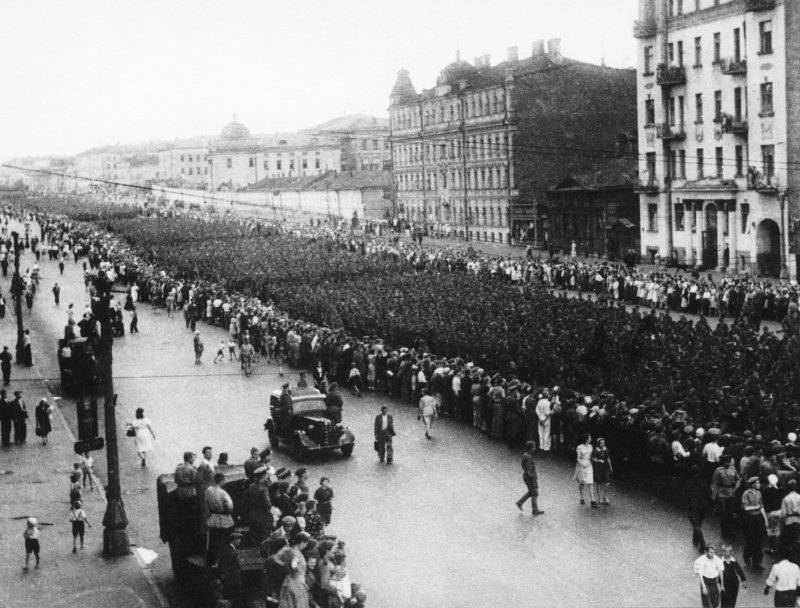
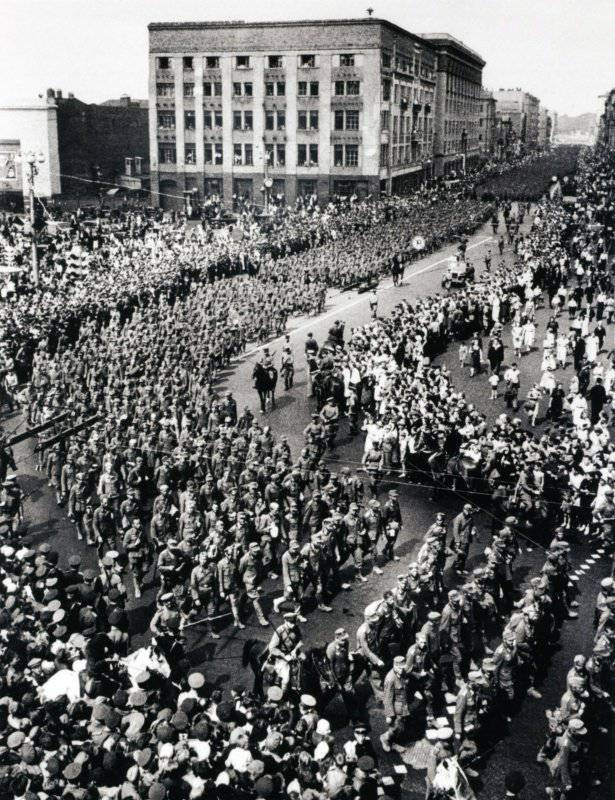
A column of German prisoners walking across Moscow, on one of the turns of the Garden Ring. 57 thousand people in columns on 600 people (including 19 generals), 20 people on the front. 17 July 1944 of the year
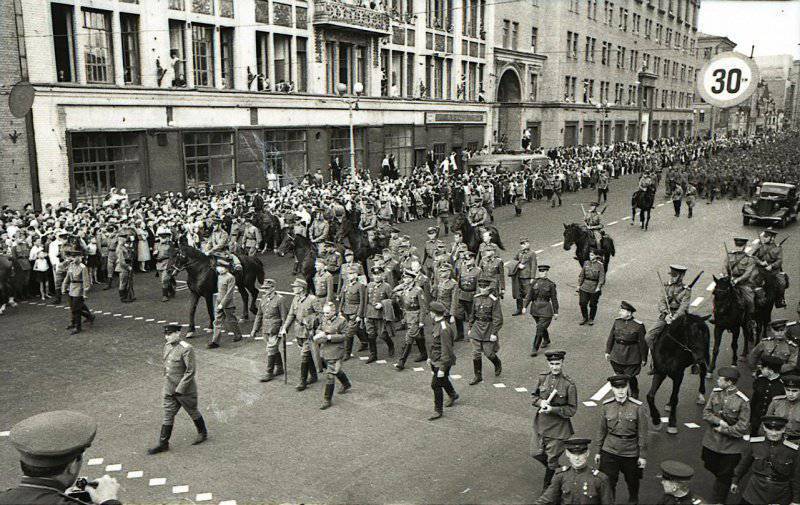
March of German prisoners in Moscow. Ahead of many thousands of columns of soldiers and officers lead a group of German generals from 19
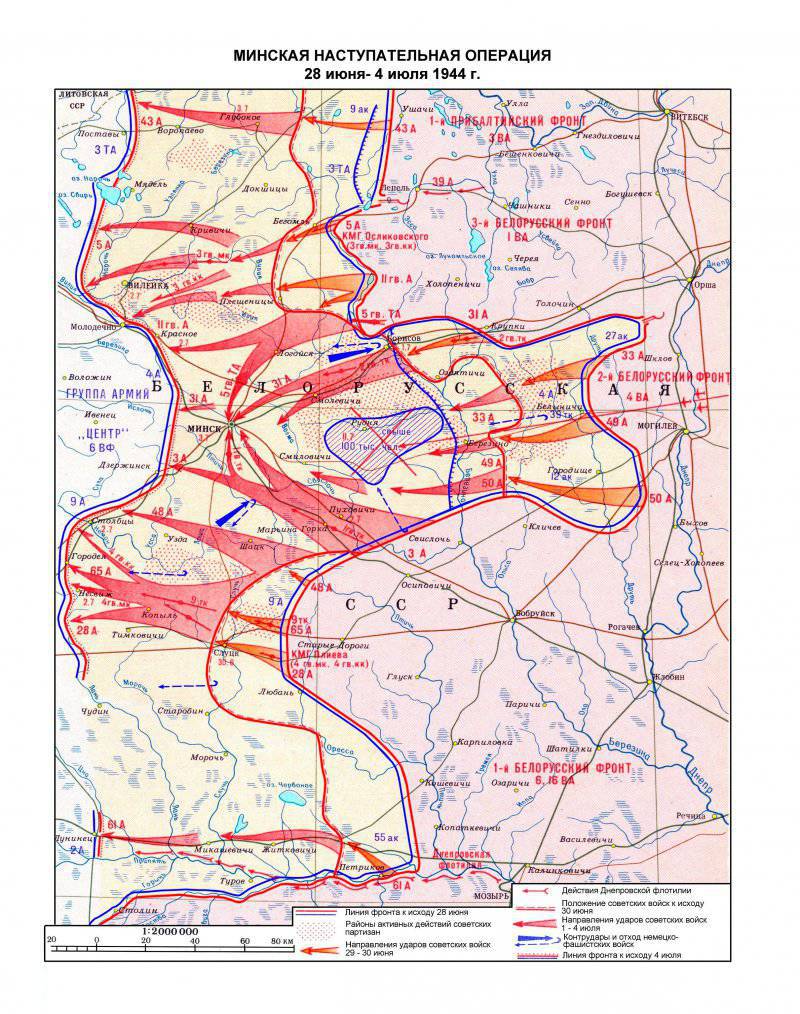
Information